eISSN: 2576-4543


Review Article Volume 2 Issue 4
Institute of Solar-Terrestrial Physics SB RAS, Russia
Correspondence: Gennady Ya Smolkov, Institute of Solar-Terrestrial Physics SB RAS, Irkutsk, 664033, p/b 291, Russia, Tel 7 3952 564552, Fax 7 3952 511675
Received: May 03, 2018 | Published: July 18, 2018
Citation: Smolkov GY. Exposure of the solar system and the earth to external influences. Phys Astron Int J. 2018;2(4):310-321. DOI: 10.15406/paij.2018.02.00104
The present review article is devoted to the consideration of the causes of the practically crisis state of study and unsuccessful attempts to explain the solar–terrestrial relationships. It substantiates the need to take into account the endogenous activity of the Earth, (in addition to solar activity and fluxes of galactic cosmic rays). Solar activity and fluxes of galactic cosmic rays contribute to their respective roles and share of external impact on the Earth. When all three external factors of influence on the Earth are taken into account, mechanisms, cyclicity, energetics, polar asymmetry, synchronism, variations in the shape of the Earth, the level of the ocean, gravity, seismicity and volcanism become understandable, as well as the previously unexplained events and processes of manifestation solar–terrestrial relationships. Endogenous activity of the Earth is caused by the gravitational actions of the Moon, the Sun and other planets in the process of barycentric motion of the solar system in the gravitational field of the Galaxy. It is shown that, under external influence on the solar system, the Earth's shells respond to it synchronously with the responses of the observed layers of the Sun's atmosphere.
Keywords: solar–terrestrial relationships (STR), solar activity (CA), galactic cosmic rays (GCR), endogenous activity of the earth (EAE), earth's center of mass (ECM), instability of the earth's daily rotation (IEDR)
The name or concept of the so–called solar–terrestrial relations formed due to the obvious, but, as it turns out, the shared role and contribution of solar activity to the Earth. Until now, the study of the environment is fragmentary in a number of directions (climatology, meteorology, oceanology, atmosphere physics, physics of the Earth, planetary geophysics, etc.) with unsuccessful attempts to explain the variability of the environment in terms of the listed disciplines.1 This caused a great harm and a long delay of the study and explanation of STRs, led them into a state of deadlock in the search for truth.2
The study and explanation STRs, depending on their state and forecast of their evolution are urgently needed in the use of modern and of future technologies. The resolution of the world forum on natural cataclysms and global problems of modern civilization (2011, Turkey) is considered to be a steady trend in the global changes in the geological and geophysical parameters of the Earth and near–earth space of natural disasters across the Earth (the interior, the hydrosphere, the atmosphere, the ionosphere, the magnetosphere) is a serious threat for the stable development of mankind.
Use in the last decade, orbital technologies for global monitoring events and processes in all shells of the Earth, the near–earth space, the interstellar medium contributed to the accumulation of modern knowledge of the variability STRs sufficient to start the system and interdisciplinary of their study and explanation with all natural causes.1,3 A favorable circumstances came as a synchronous process that is registered in all shells of the Earth and the visible layers of the Sun, testify the available on a single impact on the solar system from a supernova, the interstellar environment and the gravity of the Galaxy (Figure 1–3).4–14

Figure 1 Exposure to the Solar system begins in the Galaxy. The observed increased geological activity of the Earth and other planets, the dustiness of the interplanetary space and the presence in it of a large number of meteorites, comets and asteroids with short life times are due the on the way of solar system from the Galactic Orion arm to the Perseus branch.5–7 (http://www.astrogalaxy.ru/foto001/foto0632.jpg, http://www.epochtimes.ru/content/view/10749/5/).
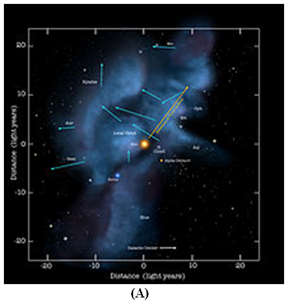

Figure 2 (A) Diagram of the local clouds of matter that the solar system is moving through, with arrows indicating cloud motion, low density warm hydrogen: https://en.wikipedia.org/wiki/Local_Interstellar_Cloud. (B) Fragment of the tail video card of the solar system, registered for the first time by NASA IBEX, its structures (http://science.nasa.gov/science–news/science–at–nasa/2013/10jul_ibex/). The interstellar wind by its action forms a tail, deflecting it in its direction. The inhomogeneities of the interstellar medium and the wind modulate the dynamics of the external effect on the solar system.13,14
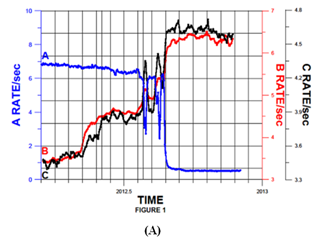

Figure 3 (A) decrease in the level of the solar wind flow to the interplanetary level (A–blue), increase in the flux of GCR (C–black) and high–energy particles (B–red) at the interstellar level during the Voyager 1 exit from the heliosphere; (B) clouds of heterogeneous medium along the route Voyager1 in October–November 2012, April–May 2013 and in February–November 2014 (http://science.nasa.gov/science–news /science in NASA/2014 /16dec_voyadgercme/).
Inference 1
Modern natural science is divided into many mono–disciplines. This makes it difficult to study and explain the manifestations of STR, since it is impossible to explain the nature of their variability by the concepts of individual branch. A systematic and interdisciplinary methodology is needed to solve problems.
The movement of the Solar system from the galactic arm Orion on the way to Perseus branch of spiral Galaxy (Figure 1)5–6,9,10 requires to take into account the possibility of influences of the galactic environment: the electro–magnetic radiation, heterogeneous, and dynamic interstellar medium, and gravitational shock waves caused by supernova explosions, when they are oriented towards the Solar system (Figure 2);4,8,15 (professionals and amateurs of astronomy in the course of the year recorded more than 300 supernova).
In the time of SA Voyager1 exit from the geosphere in 2012 registered a decrease in current solar wind to the outer level, the increase of the flow of GCR to the interstellar level, the fluxes of heavy ions and light particles outwards (Figure 3A). In the vicinity of the heliosphere in 2013 and 2014 registered the clouds of the interstellar medium of different dimenshions (Figure 3B), the crossing of which threatens the heliosphere influences the Earth and other celestial bodies of the solar system by means of "space tsunami" (NASA News: Voyager1 and Interstellar "Tsunami Waves"), or at least trigger the removal of the intense interaction of their shells.16,17
The consequences of such effects on the solar system can be traced by means of registration of synchronous responses in the observed atmospheric layers of the Sun (Figure 4–6)18,19 and all of the shells of the Earth (Figure 7–17).20–34To demonstrate the synchronous responses of the Sun and the Earth to the external impact of 1997–1998 a list of unexplained events and processes from the GEOCHANGE Report35 was used.
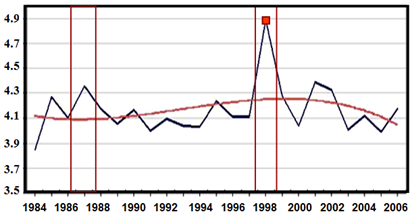
Figure 4 The abrupt change in the average annual levels of solar radiation in 1998 (Monterrey, MX, solar radiation, 07–XII.1983–2005. 1 unit=1000 kcal /m2), dark blue–midannual and brown–cubic approximation in Kcal /.12
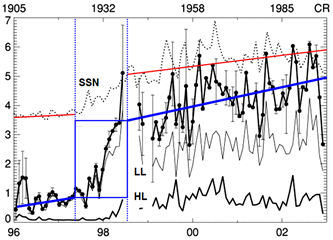
Figure 5 The jump in the CME velocity on average over the Carrington periods at LASCO (thick line with dark circles) compared to the daytime values of the number (SSN) of spots on the photosphere (visible in white light). Errors for each turnover are estimated based on SOHO data. LL and HL are the behavior of CME velocities at low and high latitudes, respectively.18
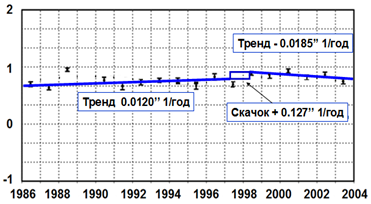
Figure 6 Linear statistical trends of the radius of the Sun before and after the jump in radius change in 1997–1998 to +0, 187. Linear trend estimates are 0.0083"/ year (before the jump) and–0.0124" / year (after the jump).19
Within the solar system the Earth is exposed to the effects of solar activity and GCR fluxes, and its endogenous activity due to gravitational influences of the Moon, the Sun and all other celestial bodies in the Solar system during its barycentric movement (Figure 7–17).3,24
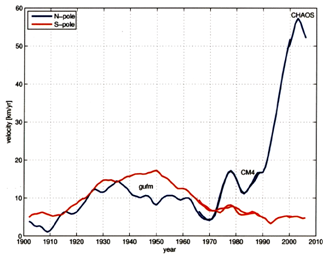
Figure 7 An intensive increase in the speed of the northern geomagnetic pole in 1998, which marks the beginning of an increase in the Earth's geodynamic activity.20 (http://geo–change.org/Pdf/Will_the_Magnetic_North_Pole.pdf;http://onlinelibrary.wiley.com/doi/10.1029/2007EO290001/epdf).
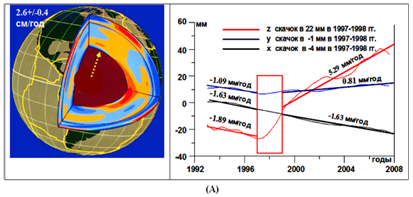
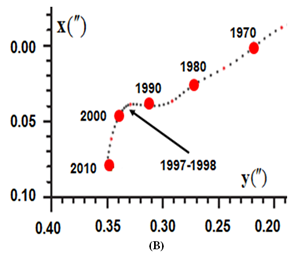
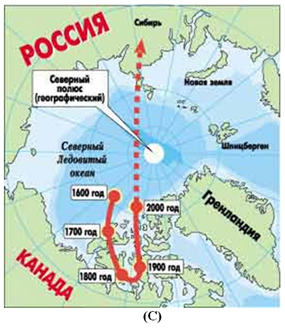
Figure 8 (A) The internal structure of the Earth, the ECM trend parameters and the jumps in the values of its Cartesian Greenwich coordinates in 1997–1998, then–the trajectory of its pole on the surface of the Earth in 1990–2010 with a turn almost 90° in 1997–1998. (B) Orientation to the area of the Taimyr Peninsula; (C) Zotov et al.21
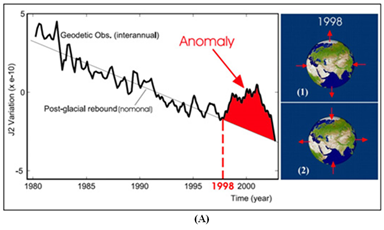

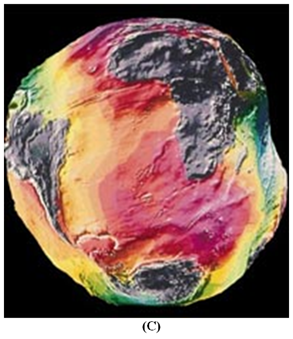
Figure 9 Change in the shape of the Earth in 1998, the coefficient J2 depends on the ratio of radii Rp/Re.
(A): Until 1998 the equatorial radii Re increased, the polar Rp decreased, since 1998 their dynamics changed to the opposite. (B): The age–old changes in the pear–shaped form of the Earth and the speed of variation in the lengths of latitudinal circles in orbital measurements with the manifestation of the polar asymmetry of the Earth.12 (C): The irregularity of the Earth's shape (geoid) is fixed by many satellites: the South of India is located in a hollow depth of ~100 meters, while Iceland is elevated by 90 meters. The satellite Grace recorded: the form of the geoid changes very quickly–much faster than the movement of the continents. In the rhythm of the seasons, the Earth rises or falls by several centimeters under the influence of regional phenomena–such as fluctuating water levels in the Amazon basin (Inopressa.ru)
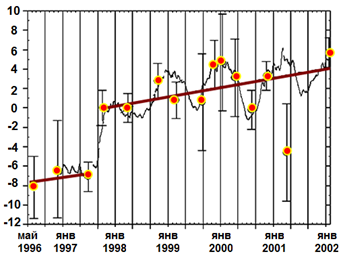
Figure 10 A jumps in gravity at the station Medicin (Italy) in 1997–1998. The ordinate shows the results of measurements on absolute gravimeters (circles) and on superconducting gravimeters (a thin black curve). The ordinate values are in microgalls.22,23 The force of attraction in different parts of the planet is not the same–mainly because of the heterogeneity of the inner composition of the Earth cortex and mantle // http://inauka.ru/news/article60330?subhtml (Figure 9C).
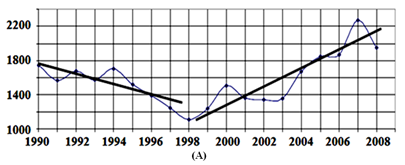
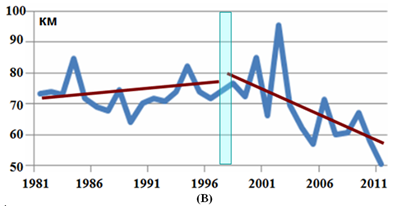
Figure 11 (A) A change in the total number of earthquakes and strong earthquakes with a magnitude >5 over the past 20 years (http://earthquake.usgs.gov/earthquakes). (B) A sharp change in trends in the average annual depth of earthquake foci occurred in 1997–1998. (http://www.novisio.com/htmlearthqt.htm).

Figure 12 Graph of the number of volcanic eruptions from 1980 to 2010. The second, hollow curve is the trend of the number of volcanic eruptions, smoothed by 11–year moving averages, the kink is the impact on the Earth in 1997–1998.35 From external influences–not indignation, but calm?
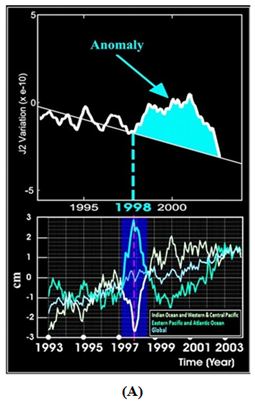
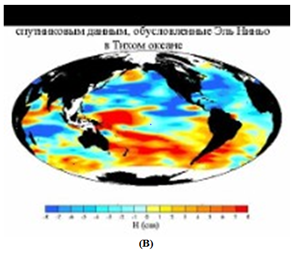
Figure 13 (A) Variations of the J2 coefficient (from above), the dynamics of ocean levels (India, the Western and Central Pacific, the Eastern Pacific and the Atlantic) and a general graph of world ocean level fluctuations (below). The maximum values of ocean level variations coincide in time with the onset of a sharp jump in the coefficient J2 (since 1998). The geophysical causes of the increase in the current J2 are not determined. This means a significant global change in the distribution of the masses in 1998.25,26 (B) The climatic significance of these rapid shifts in the ice and ocean masses remains the subject of research. Questions: To what extent are changes in the levels of the oceans, and how can El–Nino processes provoke registered changes in J2? What is their reason?).35
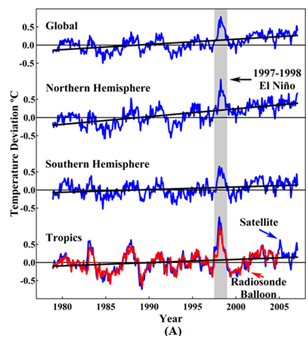
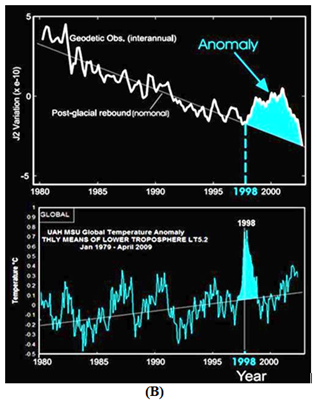
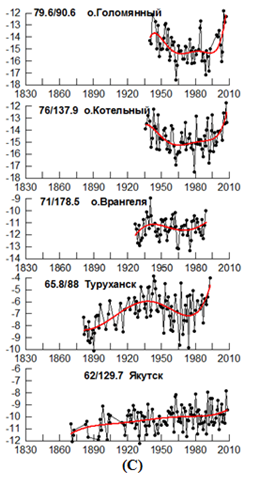
Figure 14 (A) A set of satellite microwave temperature measurements in the N–hemisphere troposphere (blue) in the range from 0 to 82.5° N. The southern hemisphere is between 0 and 82.5° S, in the tropics, between 20° N. and 20° S the globe between 82.5 n. and 82.5° S. w. between 1979 and 2007 and the results of radiosonde measurements in the tropics (red). The measurements of balloons are confirmed by satellites. Anomaly warming in 1997–1998. (gray) called El Nino, which, as a rule, does not bind to CO2.(B) Synchronous jumplike changes in the values of the coefficient J2~Re / Rp (Earth shape) and global temperature in the troposphere.35 (C)The polar regions of the Earth are most affected, which explains their increased geodynamic and geophysical activity. For example, the increased variability of the average temperatures in the Taimyr region, where the pole of the modern displacement of the ECM is projected. On meteorological stations Golomyanny and Kotelny in 1997–1998 recorded an abrupt warming. At the latitude of Yakutsk–only the evolutionary behavior of the average temperature. 28,28,33,34
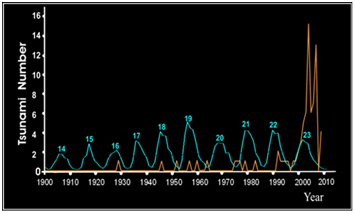
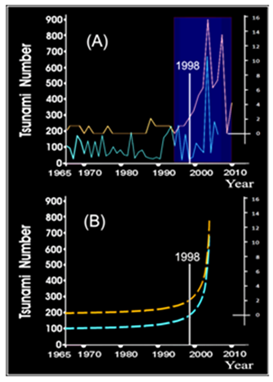
Figure 15 Top: Comparison of the graph of the number of strong tsunamis (yellow) with the CA cycle (blue). As can be seen from the comparison, there is no one–to–one relationship between tsunami and SA, only partial–during the 16, 18, 19, 21, 22 and 23rd cycles of the SA. With strong earthquakes, as is known, are closely related tsunami, which, as a rule, are the consequence of strong earthquakes in the water environment. Bottom: graphs (A) show the dynamics of annual tsunami numbers: yellow–catastrophic, blue–weak and medium. On the graphs (B)–respectively, their exponential dynamics. The state of the environment, which is affected by the tsunami to full depth, leads to a huge exchange of masses of ocean water. The number of tsunamis in the late 1990s grew nonlinearly, exponentially.35

Figure 16 Variations in the deviation of the mean–square total electronic content (TEC) of the ionosphere disturbance with a sharp decrease in 1997–1998. at the station of its sounding at a latitude of more than 60° N.
TEC is the total number of electrons in a column with a cross–section of 1 m2 from the receiver to an orbit height of–20,000 km.30,31
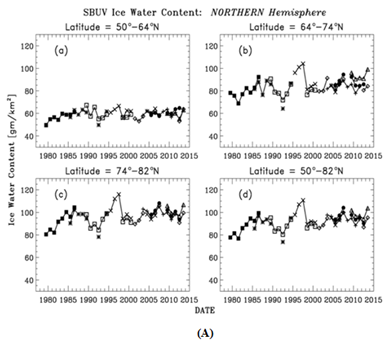
Figure 17 (A) Synchronous effects of trends in polar mesospheric clouds in 1997–1998. At various intervals of the latitudes of the northern hemisphere.32 (B) Heights of the layers of the Earth's atmosphere.
Inference 2
Synchronous events and processes recorded on the Earth and on the Sun indicate their subjectibility (susceptibility) to external influences.
Traditionally established approaches to the study and explanation of solar–terrestrial relations are limited to the search and ascertainment of the correlation of terrestrial responses only to solar activity and GCR fluxes, attempts to explain events and processes by the outlooks of the corresponding discipline of researchers. Forced use to study past links of imperfect proxy data leads to uncertainty in research results. National and international scientific programs and projects have not led to the generally accepted opinion about all the external factors, their roles and relations (with a huge number of analyzes and publications on climate and solar–terrestrial connections, including 10 reasons of Global Warming from the Paris Conference). As noted above, not all external factors affecting the Earth are taken into account. The energetics and mechanism of solar–terrestrial relations, their cyclicity, polar asymmetry, synchronism, instability of the Earth's daily rotation, spasmodic development and other types of responses of the shells of the planet are not explained. Accounting for the endogenous activity of planetary geophysics has left these questions unanswered because it was considered only tectonics. The study and attempts to explain the characteristic properties of solar–terrestrial connections were in protracted crisis.36
One of the permanent properties of the environment is its variability on different time scales. The methodology of the study of the manifestations of the STRs is reduced mainly to clarify the linkages and interrelations of responses of the Earth to outside influence, still mostly just CA and GCR fluxes, by means of analysis of correlations of trends of interesting indices and modelling relations between them in the search for explanations of mechanisms and peculiarities of the manifestation. To understand the current state of relations, it is necessary to consider their evolution in the past. Since data of a registration tool for the required time scales absent, reseachers is forced to use proxy data, which inevitably leads to uncertainties of the results of study of the STRs.1,3,37,38
The literature on the effect of variable solar activity, for example, on the climate, is extensive. However, much has been based on inadequate statistics and doubtful procedures. The widespread errors and their causes were specified and discussed.39 Selection of terrestrial responses may often be caused (inadvertently or otherwise) by using the intervals of restricted data and/or by choosing the compared parameters. This is the main reason of specific problems when studying the solar activity effect on the climate. The climate inner variability phenomena are often neglected or underestimated. There are inner variations (particularly, associated with oceans on decadal time scales), and a common error is in refitting the data, thereby erroneously assigning the variations to an external solar origin. There are a great number of publications addressing the variations within the periods close to solar activity cycles and/or correlations with a solar activity cycle at a fixed time lag. Testing, at least, some of them show that they are unlikely to be solar–activity caused, and that they, most likely, reflect other natural cycles of the climate system, or they are the result of harmonious combination of different long–term cycles. Statistically significant correlation or detection of a periodic signal (forcing) establish neither a cause–and–effect relation, nor the accepted time lags, nor phase relations of the coupled systems, including stationary variations. The question arises: is it possible a realistic mechanism or a series of mechanisms that could meet the correlation conditions? 39 Finally, one should realize and substantiate the presence of physical sense and the role of the mean annual temperature Tm/year.40
The solar activity variation energetics entering the Earth is lower, than the energy of terrestrial responses. Therefore, to elucidate the detected correlations, proposed are non–linear increase mechanisms, feedbacks and interconnections, simulations by using different interconnections among terrestrial processes, their parameters.39,41 There are place a clear insufficiency of statistical analyses and correlations, the need to clarify the causes and mechanisms of their manifestation, the search for quantitative estimates of analysis of the role and contributions of the underlying factors in significant changes, for example, the Earth's climate, with continue orientation to the anthropogenic factor.41
Therefore, some new approaches, where researchers42–49 take into account not only terrestrial responses to external forcings (like it was in the past), but also some intermediate ones (e.g., Earth diurnal rotation instability, non–tidal forcings), and even partially initial (natural external) and cosmophysical forcings, may be regarded as progress. But the authors of such studies often confine themselves to logical constructs, they do not numerically estimate the dynamic and energetic effects, do not explain the character of and mechanisms for the response.37,38 The predictions of the IPCC reflect the range of possible values covered by the term "likely" (more than 66 % probability according to experts) for selected scenarios of the impacts.50 Good example of a limited, subjective approach to the study of STRs is Word Climate Research Programme (https://www.wcrp–climate.org/).
Man's living conditions and activity depend, first of all, on the climate. The climate variability is one of indicative informative manifestations of solar–terrestrial relations that are associated with many terrestrial responds to all external actions,51–53 i.e., explicitly multivariate manifestation of STRs. The Intergovernmental Panel on Climate Change (IPCC) finally recognized global warming, but greenhouse gases are still considered to be its principal cause, i.e., the anthropogenic factor appears to be the main (Sobering IPCC Report, 2014). The most convincing experimental corroboration of a minor role from the greenhouse effect is the high–precision satellite observations evidencing an essential change in the climate system global energy balance over the last 20 years.54 The imposed consensus of recognizing the greenhouse effect to be the principal cause of the climate variability caused by the anthropogenic factor affected harmfully the clarification of the STR nature.2 Instead of relying solely on the UN IPCC for scientific advice, policymakers should seek advice from an independent, non–governmental organizations and scientists who are free from financial and political conflicts of interest.55
STRs manifest processes and events occurring in the internal and external layers of the Earth: solid and liquid cores, solid and plastic mantle, lithosphere, atmosphere, magnetosphere, and even near–earth space (Figure 7–17). Therefore, STRs is inherently much wider than the concept of space weather. To examine the relations of processes and events happening in all these layers of the Earth, is recognized as one of the three main directions in the Earth Sciences.56 The necessity of systemic and interdisciplinary studies STRs is increasing.1
In search of the causes of the warming scientists went through virtually all possible land–based factors, sometimes even very far in nature from climatic variations, specify the drift of the geographic and geomagnetic poles of the Earth, the daily variations of the Earth's rotation and the increase of endogenous, namely volcanic activity of the Earth. The traditional limitation of the current concepts on the variability of the natural environment and the factors causing them have led the co–authors of an extensive review (15 scientists from 18 scientific organizations) to the forced listing of a large number of questions left unanswered and explanations, as well as listing the required additional information and data, further clarify the mechanisms, etc.39
Very interesting is the discovery of a correlation between the current warming of the earth's surface and the evolution of the solar dynamo in 1610–1970: a residual excess of 0.3° in 1999 was found, a triangular weighted balance for the period 1990–2008 The solar effect on ground temperature, associated with a significant backward coupling, is a regularly occurring feature explaining some well–observed events.57 But the solar dynamo operates in varying modes, as in evolutionary times, and at times thousands–tens of thousands of years.58,59
Studying the Earth diurnal rotation variations of non–tidal origin invoced the emergence of hypotheses to elucidate STRs.37,38,60,61 Among the climate factors, noted were: the Earth polar motion, mechanical forcings on the Earth atmosphere, global water exchange, angular momentum exchange between the mantle and the Earth liquid core, and, finally, gravity forcing62–64 by the geomodel.1,28,29,34 But, when addressing the associations the Earth diurnal rotation variations and the global variations in the natural processes, there appeared contradictions, to eliminate which the attention was forced to be paid to the existence of the third cause simultaneously affecting the processes in the Earth core and in the climate system. All the suite of the phenomena originating herewith in the Earth shells is referred to as “a generalized tide”,62–66 because, besides classical tides, the gravity from the Moon, Sun, and other planets of non–spherical, non–uniform Earth shells achieving eccentric positions results in relative displacements and oscillations of their mass centers, in forced mass travels.12 The long–term Earth diurnal rotation variations correlate with geophysical, hydrometeorological, geomagnetic, biological, etc., processes,68,69 because all of the latter have the same celestial–mechanical original cause, generalized tides. Thus, the long–term Earth rotation angular velocity variations are an integral index of global changes.62–65
The similarity of the characters of the chronology of process of a temporary slowing of the trend, the average surface ocean temperatures and total electron content (TEC) in the iono–sphere (Figure 13&16) (see below as synchronicity geophysical and geodynamic events and processes with events and processes on the Sun, Figure 4–17 indicate a synchronous (simultaneous) external effects in the shells of the Earth and in observable layers of the Sun shown on the drawings intervals.
Inference 3
The United Nations has recognized its forecast of global warming as erroneous, but still considers the main anthropogenic factor. The unsuccessful study and attempts to explain the registered manifestations of STR show a protracted crisis in the solution of fundamental and applied problems. Scientists, independent of financial and political interests, are forced to look for additional factors of external impact on the Earth. Actively working scientists of the world could not offer any theoretical justification for the changes in the environment on the Earth.
As part of the Solar system, the Earth is continuously exposed to external natural influences of the Moon, the Sun and other planets. The most important defining issues of the theory of natural planetary processes on Earth (and similarly for other celestial bodies) are the energy sources of the EEA and the basic mechanism of cyclic excitation energy of celestial bodies. The solution to these age–old problems is proposed based on the mechanism of excitation of shells of a celestial body other external celestial bodies. Guideline develop geodynamic concept is that planets, Moons and the Sun constitute a system of shells (from the Earth: core, mantle, etc.), which make relative to each other by small translational and rotational motion, and deformation, and other changes caused thanks the gravitational influence of all the surrounding celestial bodies in the Solar system.12
Geodynamics of the forced oscillations of the core and mantle of the Earth under the gravitational attraction of external celestial bodies has developed since 1995. The most important result was the prediction and the justification for the existence of the century trend of ECM relative to the mantle, received clear confirmation in the data of space geodesy and its mechanical interpretation as the consequence of centuries near the Northern polar drift of the Earth's core relative to the mantle (at a speed of 27.4 +/–0.8 mm/year). The change in time of the tides in the viscoelastic mantle of the planet caused by the gravitational forces interact with a movable core, leads to the dissipation of mechanical energy in the material of the planet (the mantle), which is converted into heat and to forms a temperature field inside the planet. This and many other prob–lems of geodynamics, geophysics and other sciences about Earth are solved using a gravitational mechanism of the forced excitation of the core and mantle of the Earth.12
Displacement of the core leads to the displacements of ECM relative to the mantle, which is currently (since about 1993) available for study by methods of space geodesy. At the same time revealed wide variations ECMs and discovered century–long trend in a northerly direction (in the direction of peninsula Taimyr).70 On the other hand the displacements of the ECM is possible to restore the style and features of the relative displacement of the core and mantle of the Earth, to study geodynamic consequences of these displacements such as deformation of the layers of the mantle, and variations of its elastic energy, power dissipation and the formation of a heat flow on the planet, other physical fields, the redistribution of fluid masses, etc.
Cyclic displacements of the core with its enormous excessive mass (of about 17 lunar masses) produce cyclic gravity effects on all the Earth shells, including its biosphere. Every living thing on the Earth has been under a vigilant attention and control of the "Earth heart” that is the oscillating core–mantle system. All geological, geophysical, and geodynamic processes have a cyclic character and occur synchronously. The present–day data on space geodesy and on the variations in the second–and higher–order harmonic coefficients evidence explicitly the existence of the centennial trend in the Earth mass center variations. Actively working scientists of the world could not, indeed, propose any theoretical justifications to the studied geodesic Earth variations.12
The geodynamic model for the core forced relative displacements has already obtained impressive applications when studying and solving complex geophysical problems. A number of geodynamic and geophysical phenomena have obtained a theoretical explanation in good consent with observational data. In geodynamics, when elucidating the centennial pole drift of the rotation axis and non–tidal acceleration in the Earth axial rotation (Figure 8).71 In gravimetry, when elucidating the observed centennial gravity variations at the known leading gravimetric stations of the world (Figure 10): New York, Alesund (Norway), Syowa (Antarctica), Churchill (Canada), Wuhan (China), Medicina (Italy), Bologna (Italy), Membach (Belgium) and Metsähovi (Finland). In oceanology, when elucidating the centennial variation in the ocean level, both global (Figure 13) and mean, in the Northern and Southern Hemispheres. In geodesy, when interpreting the observed centennial shortening of the latitude circles in the Northern Hemisphere and their elongation in the Southern Hemisphere. Thereof, the Earth has not a spherically symmetric, but rather "quasi–pear" shape (Figure 9). Also, this geodynamic model enables solving the problems in seismology (Figure 11) and climatology (Figure 14), and in a number of other geophysical, geodynamic, geodesic phenomena on the Earth and on other planets and satellites of the Solar System.12
By estimates, proceeding from the Earth endogenous activity concept, the Earth energy balance (with simplifications in expressing force functions of the Newtonian and gravity couplings among celestial bodies and the Earth shells, and with an assumption of circular orbits of planets) and the power of processes are: seismic events–3х1010 W, volcanic events–1010 W, thermal convection–1013 W, heat flux–(4,4–4,8)х1013 W, tides–4х1011 W, dissipations due to oscillations of the core and to the mantle visco–elastic deformations–3,38х1014 W, the gross power of the energy dissipation in the Earth mantle–1014–1015 W (Barkin, 2002), (upper bounds 1,45х1016 W.72 The gravity differentiating of the Earth substance is the most powerful source of the Earth endogenous energy. It may simultaneously feed the Earth magnetic field under the effect of all the surrounding celestial bodies.69 All the other endogenous power sources are either incommensurably less, that the above numbered, or are completely reversible due to a convective mass exchange in the mantle. The endogenous power sources also excite the Earth magnetic field. It is considered almost obvious that the geomagnetic field generation is related to the convective processes developing in the electro–conductive substance of the outer (liquid) core of the Earth. The addressed mechanism for the planet shell dynamics may supply the energy to all the Earth main natural processes, such as tectonic motions (including horizontal motions of lithospheric plates), rises and sags of the crust, lithosphere, and other Earth shells, formation of consolidated layers, of fissure and fault systems, etc. It is not ruled out that the starting–point is a weak background interstellar magnetic field I.11
The mechanism of the dynamics of the shells of the planet could provide energy to all basic natural processes of the Earth (tectonic movement, including horizontal movement of tectonic plates, uplift and deflection of the crust, lithosphere and other layers of the Earth, formation of compacted layers, the formation of systems of cracks and scrap, etc.). The mechanism of the dynamics of the shells of the planet is provide energy to all basic natural processes of the Earth (tectonic movement, including horizontal movement of tectonic plates, uplift and deflection of the crust, lithosphere and other layers of the Earth, formation of compacted layers, the formation of systems of cracks and scrap, etc.), the more so for interactive the moving layers of the oceans and atmosphere.2,12,73–82
Inference 4
At the end of the 20th–the beginning of the 21st century, the concept of endogenous activity of the Earth finally appeared which enabled us to propose an adequate geodynamic model. Its impressive applications have already been obtained in the study and solution of complex geophysical problems. A number of geodynamic and geophysical phenomena have been theoretically explained in accordance with observational data in geodynamics, gravimetry, oceanology, geodesy, seismology, volcanology, climatology and a wide range of other phenomena on the Earth and other planets and their satellites. The energy balance of the Earth and the power of natural processes are estimated. The mechanism of dynamics and interaction of shells of the planet can fully provide all the basic natural processes of the Earth.
The Solar system and the Earth are continuously exposed to external influences. An analysis of the state of the study of external effects on the Earth has shown that in order to obtain answers to the questions noted in the article, it is necessary to take into account (along with the SA and the GCR fluxes) the endogenous activity of the Earth caused by the gravitational effects of the Moon, the Sun and other planets in the process of barycentric motion of the solar system, as well as the effects of external influences on the Solar system as a whole. This allows us to explain the mechanisms of effects and their characteristic manifestations: cyclicity, energy, polar asymmetry, synchronism, variability of Earth`s form, Earth`s tectonics, and other responses to external influences.
The work was carried out within the framework of basic funding of the program of fundamental scientific investigations II.16. The author is grateful for research materials borrowed them from the Internet clear.
Author declares there is no conflict of interest.

©2018 Smolkov. This is an open access article distributed under the terms of the, which permits unrestricted use, distribution, and build upon your work non-commercially.